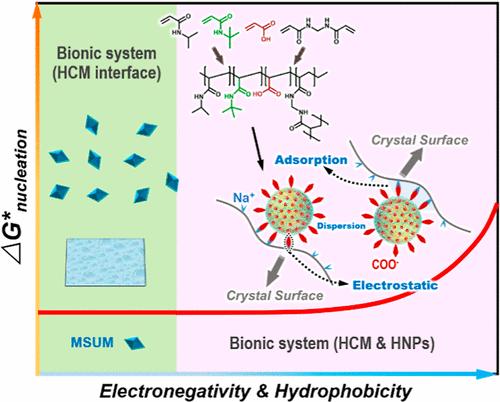Our official English website, www.x-mol.net, welcomes your feedback! (Note: you will need to create a separate account there.)
Hydrogel Nanoparticles Enable Nucleation Barrier Regulation and Ion Anchoring as an Alternative Pathway for Monosodium Urate Monohydrate Crystallization Control
ACS Nano ( IF 17.1 ) Pub Date : 2024-05-13 , DOI: 10.1021/acsnano.4c02040 Yingshuang Meng 1 , Lingfeng Wang 1 , Guangming Zhao 1 , Jibo Diao 1 , Zhibo Qi 1 , Mingyang Yu 2 , Zhonghua Li 1 , Yuchao Niu 1 , Gaohong He 1 , Xiaobin Jiang 1
ACS Nano ( IF 17.1 ) Pub Date : 2024-05-13 , DOI: 10.1021/acsnano.4c02040 Yingshuang Meng 1 , Lingfeng Wang 1 , Guangming Zhao 1 , Jibo Diao 1 , Zhibo Qi 1 , Mingyang Yu 2 , Zhonghua Li 1 , Yuchao Niu 1 , Gaohong He 1 , Xiaobin Jiang 1
Affiliation

|
Gout flare-up, commonly resulting from monosodium urate monohydrate (MSUM) crystallization, has led to painful inflammatory arthritis among hundreds of millions of people. Herein, a kind of hydrogel nanoparticles (HNPs) with specific properties was developed, aimed at providing a promising pathway for MSUM crystallization control. The experimental and molecular dynamics simulation results synchronously indicate that the fabricated HNPs achieve efficient inhibition of MSUM crystallization governed by the mechanism of “host–guest interaction” even under very low-dose administration. HNPs as the host dispersed in the hyperuricemic model effectively lift the relative heterogeneous nucleation barrier of the MSUM crystal and hinder solute aggregation with strong electronegativity and hydrophobicity. The initial appearance of MSUM crystals was then delayed from 94 to 334 h. HNPs as the guest on the surface of the formed crystal can decelerate the growth rate by anchoring ions and occupying the active sites on the surface, and the terminal yield of the MSUM crystal declined to less than 1% of the control group. The good biocompatibility of HNPs (cell viability > 94%) renders it possible for future clinical applications. This study can guide the rational design of inhibitory nanomaterials and the development of their application in the control of relevant pathological crystallization.
中文翻译:

水凝胶纳米颗粒能够实现成核势垒调节和离子锚定,作为一水尿酸钠结晶控制的替代途径
痛风发作通常是由一水尿酸钠 (MSUM) 结晶引起的,已导致数亿人患上痛苦的炎症性关节炎。在此,开发了一种具有特定性质的水凝胶纳米粒子(HNP),旨在为 MSUM 结晶控制提供有前景的途径。实验和分子动力学模拟结果同时表明,即使在非常低的剂量下,所制备的HNPs也能通过“主客体相互作用”机制实现对MSUM结晶的有效抑制。 HNPs作为分散在高尿酸血症模型中的主体,有效解除了MSUM晶体的相对异质成核势垒,并具有强电负性和疏水性,阻碍溶质聚集。 MSUM 晶体的最初出现从 94 小时延迟到 334 小时。 HNPs作为形成晶体表面的客体,可以通过锚定离子并占据表面活性位点来降低生长速率,MSUM晶体的最终产率下降至对照组的1%以下。 HNPs良好的生物相容性(细胞活力> 94%)使其在未来的临床应用成为可能。该研究可指导抑制性纳米材料的合理设计及其在控制相关病理结晶方面的应用开发。
更新日期:2024-05-13
中文翻译:

水凝胶纳米颗粒能够实现成核势垒调节和离子锚定,作为一水尿酸钠结晶控制的替代途径
痛风发作通常是由一水尿酸钠 (MSUM) 结晶引起的,已导致数亿人患上痛苦的炎症性关节炎。在此,开发了一种具有特定性质的水凝胶纳米粒子(HNP),旨在为 MSUM 结晶控制提供有前景的途径。实验和分子动力学模拟结果同时表明,即使在非常低的剂量下,所制备的HNPs也能通过“主客体相互作用”机制实现对MSUM结晶的有效抑制。 HNPs作为分散在高尿酸血症模型中的主体,有效解除了MSUM晶体的相对异质成核势垒,并具有强电负性和疏水性,阻碍溶质聚集。 MSUM 晶体的最初出现从 94 小时延迟到 334 小时。 HNPs作为形成晶体表面的客体,可以通过锚定离子并占据表面活性位点来降低生长速率,MSUM晶体的最终产率下降至对照组的1%以下。 HNPs良好的生物相容性(细胞活力> 94%)使其在未来的临床应用成为可能。该研究可指导抑制性纳米材料的合理设计及其在控制相关病理结晶方面的应用开发。































 京公网安备 11010802027423号
京公网安备 11010802027423号